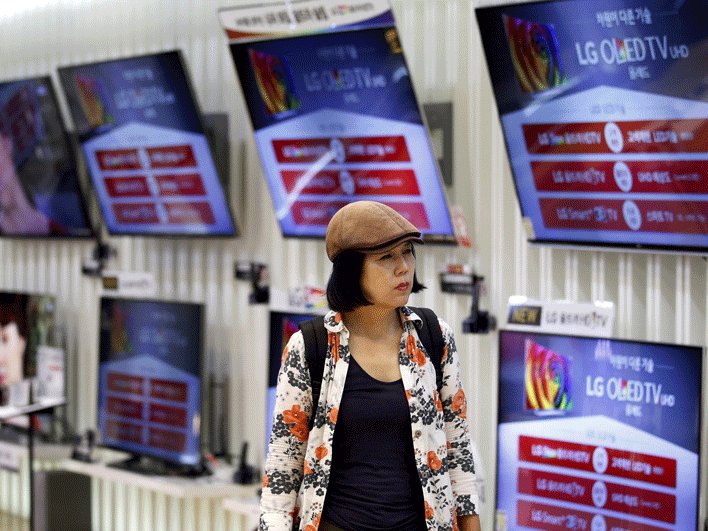 A customer browses LG Electronics’ television sets, which are made with LG Display flat screens, in Seoul, South Korea, on July 23, 2015.REUTERS/Kim Hong-Ji
A customer browses LG Electronics’ television sets, which are made with LG Display flat screens, in Seoul, South Korea, on July 23, 2015.REUTERS/Kim Hong-Ji
South Korea’s export data for June has been released, and the numbers are slightly better than expected.
The data suggests that South Korea’s second-quarter exports have, to some extent, bounced back from the first quarter’s lows.
The country’s export value rose 9.9% versus last month, compared to a 0.7% YoY drop in May. Excluding ship exports, which often inflate the numbers, export value still improved by 3.6%.
This seems to bode well for the global economy. South Korea is known as an economic “canary in the coal mine,” because it’s the first country to release its trade data for the preceding month and because it’s the fifth-largest global exporter, which makes it a pretty good indicator of global trade activity.
But despite the rise in exports in June compared to May, South Korea’s exports are still decreasing on a year-over-year basis, albeit less severely — -2.7% this month versus -6% in May. And the country continues to face threats from China’s increasing industrial sophistication, which economists have been warning will soon surpass South Korea’s.
Over the past decade, Chinese companies have been rapidly moving up the value chain, producing the high-end goods that are normally imported from more advanced countries. This has had some positive effects in the region — less advanced countries, such as Vietnam and Bangladesh, have taken the opportunity to take China’s place in low-end manufacturing — but it’s been particularly disruptive for South Korea.
China is now producing the intermediate goods that it used to import, as well as producing and exporting some of the high-end technology that South Korea was known for, such as mobile phones and flat-screen TVs.
So not only do they not need South Korea’s imports, but they’re also taking over much of it’s market share in these key sectors — a big reason that exports have been declining in the past few years.
According to a new research note from Capital Economics, historically it has been mostly South Korea’s electronics companies that have suffered amid increased competition from China, but that could soon change as well.
Chinese car companies have been doing well, and could soon gain market share from South Korean companies. Morgan Stanley calculated that automobile exports declined 12.3% — on a YoY basis — in June, compared to 8.9% in May. And the auto industry isn’t the only business being threatened by China.
South Korea’s mobile-phone exports decreased 36.4% on a YoY basis in June, versus a 26.5% drop in May, thanks to gains made by China.
Additionally, China is also rapidly gaining market share in the shipbuilding industry, and recently overtook South Korea as the world’s biggest shipbuilder.
As China continues to advance its technology and gain market share in high-value products, South Korea’s trade will likely continue to decline.
Some South Korean companies have been attempting to take advantage of the booming Chinese consumer sector to establish themselves as exporters of premium consumer goods, but these exports currently account for just 3.4% of total exports.
As South Korea deals with this competitive threat, as well as the potential impact on trade from the Brexit, its growth prospects — and thus, perhaps, those of the global economy — do not look strong. Capital Economics estimates an average growth rate of just 2% over the next decade.















